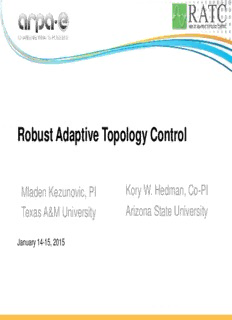
Robust Adaptive Topology Control (RATC) - ARPA-E PDF
Preview Robust Adaptive Topology Control (RATC) - ARPA-E
Robust Adaptive Topology Control Mladen Kezunovic, PI Kory W. Hedman, Co-PI Texas A&M University Arizona State University January 14-15, 2015 System Integration • Robust Adaptive Topology Control (RATC) adds flexibility to system operations and can be used for a variety of purposes Power Grid Information Technology Optimization Integrated Infrastructure RATC Solution 1 Outline • Background - Phase II: Reliability Focus - Objectives and Demonstration - RATC Support Functions, Data Layer and Communications - Learning more about RATC • Key Takeaway Points - Corrective RATC and Tool Development - Post-Contingency Corrective Transmission Switching • Examples - Results: PJM Test Case - Results: ISONE 2 Phase II: Corrective RATC Post-contingency corrective transmission switching • Shortly after a contingency, take a line out of service (as a corrective action) • Implement at most 1 corrective switching action • But: identify multiple potential switching actions, in advance, per contingency to provide operators choice • Perform stability studies to confirm switching actions 3 Objectives • Use demonstration example to compare current needs and RATC benefits: • AC based • HPC multi-core, multi-thread capable • Open source • Assure topology control: • Stability • Monitor breaker reliability and associated switching risk • Adjust relay settings • Have reliable indicators for a need to switch lines • Analyze communication requirements 4 DemonstratiRoAnT ECx Daemmpolen stration ‣ Uses PowerData’s generic Cascadia model within the PowerSimulator ‣ Demonstrates RATC within the Contingency Analysis process using IncSys Training Scenarios 5 RATC Support Functions ‣ Relay Mis-operation Detection – Fault confirmation – Mis-operation detection ‣ Circuit Breaker Operation Evaluation – Circuit breaker health assessment ‣ Relay Setting Coordination Check – Relay settings evaluation – Relay coordination check 6 RATC Data Layer RATC Data Layer • Supports data flows between RATC components and external data sources • Provides reliable data storage and retrieval services • Provides API to RATC components to obtain data • Based on the Apache Camel Framework Communication Environment Cross-traffic (varied from 0% to 75% of Fractional T-1 capacity) Test file transfer flow (file size varied from 64KB to 2MB) H6 Eth0: 10.10.2.4 H2 Ethernet switch Ethernet switch 10.10.2.0 network Ethernet switch “DummyNet Ethernet switch 10.10.4.0 network R1 10.10.3.0 network Bridge” 10.10.3.0 network R2 Eth0: 10.10.4.6 “Cross Traffic - Destination” “Cross Traffic – Source “ Eth0: 10.10.4.7 H1 em0 ep0 Eth0: 10.10.4.1 Eth0: 10.10.2.1 Eth1: 10.10.3.1 Eth2: 10.10.3.2 H3 H4 H5 Eth0: 10.10.2.5 “SSFuTbPs Staotuiornce ” F D6re4al,ca 1tyi2:o 82n, am2l5 sT6e-,1 c3 e8x4p aenrdim 5e1n2tKsb rpatse s varied as follows: “ SRFATTPC DUattilait Cy oFnilcee Cnetrnatteorr ” RAcAtTivCe MDaQt aB Lroakyeerr C o RmApToCn e nt Queue size: 100 slots Eth0: 10.10.4.8 Eth0: 10.10.4.9 Model of RATC system elements: H1 – Substation, H3 – Control Center (CC) Data Concentrator (RATC Utility File Center), H4 – RATC Data Layer, and H5 – RATC Component. RATC Learning Opportunities Learning more about RATC ‣ Full RATC Demonstration – ARPA-E Technology Showcase Feb 10-11, 2015, Booth 528 ‣ RATC User Forum: The ISONE Experience March 12, 2015 – @ FERC - 888 First Street, NE, Washington, DC 20426 – Full RATC Demonstration – Report of RATC performance at ISONE 9
Description: